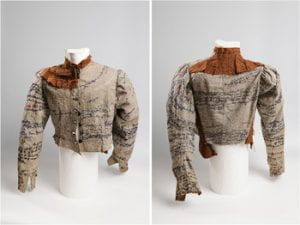
Some years ago I chanced across Gail Hornstein’s ‘Agnes’s Jacket: A psychologist’s search for the meaning of madness’. It was a fascinating read and led me on a journey to discover more about the ‘lunatic asylums’ of the C19th – their ethos, culture and management – and the people (women in particular) who lived there. Agnes Richter was a patient, first admitted in 1893 to Dresden City Lunatic Asylum, aged 51, and in 1895 she was transferred to Hubertusburg in Saxony, where she lived until her death in 1918. She made her jacket from ‘institutional’ linen and embroidered it in around 1895.
Agnes’s jacket has survived because Hans Prinzhorn ‘collected’ it just after WW1, having been asked by Heidelberg Hospital’s lead psychiatrist, Karl Wilmanns, to expand their existing teaching collection and to analyse the exhibits as part of a scientific research study. The label attached to the jacket by its sender suggests that Agnes had also embroidered her other clothes. Certainly, she had worked in Dresden as a seamstress and when admitted to Hubertusburg, her possessions were listed as:
1 coat
4 dresses (1 silk)
3 woollen skirts (hand woven)
2 jackets
7 shirts
5 handkerchiefs
14 pairs stockings
1 pair garters
2 pairs gloves
2 corsets
1 tablecloth, clockcase and chain, set of teeth(!) 1 pair spectacles.
Prinzhorn, however, was not impressed: his 1922 book on the artworks in his collection doesn’t mention the jacket and largely ignores the work of other women patients.
I am utterly intrigued by the idea of this jacket, stitched inside and out with what appears to be repetitive autobiographical text. It has never been completely deciphered because Agnes used an old dialect and Gothic script. Text from one side of the fabric impinges on that that on the other making it difficult to tell which wording belongs to which side; and threads on the inner surface have rubbed away through wear.
Some phrases have been identified though:
‘my white stockings’ ‘no cherries’ ‘brother freedom’ ‘my money’ ‘no-one in Hubertusburg’ ‘I plunge headlong into disaster’; plus Agnes’s laundry number.
Agnes’s patient casenotes also still exist. These show that when she was admitted to Dresden, Agnes was agitated and appeared to be paranoid. She told doctors on a number of occasions that her money had been stolen; and that she wanted legal action taken against the people who had ‘put her in the asylum’. Her admission notes to Hubertusburg assign a diagnosis of paranoia with auditory hallucination. She believed that she had ‘ended up in the asylum’ through ‘conspiracy of the worst kind, lies and deception.’ So it would be easy at the same time to dismiss Agnes’s claims of unfair incarceration but to empathise with her rage and confusion. But she might also have been correct in her allegations. In an article about the Prinzhorn Collection Thomas Roeske, its chief curator, acknowledges: ‘In the mid-nineteenth century, there was less tolerance of deviation from assumed norms and much greater stigmatisation.’ He goes on to describe how differently men and women were treated, suggesting that men were admitted to asylums if they couldn’t cope in the outside world. That is, if they couldn’t manage their expected role in society or abused their position. Whilst women might be admitted if they simply behaved outside of society norms/ expectations by failing to conform to rules, stay quiet and display orderly, obedient attitudes.
This context, and the neuroscience experiments that we will carry out as part of our project, might help us to begin to understand Agnes’s purpose in making and wearing her jacket, and I want to explore these ideas further.


Hi,
I’m fascinated by Agnes’ jacket and the story behind it too. I’d like to know if you were able to learn more about the story, her life, what was in her mind.
Hope I can get to see your investigation. I’ve embroidered a jacket thinking about Agnes’ real personality (everything they couldn’t see from her back then).
Thank you,
Josefina
Hi Josephina
Really good to hear from you. Would love to know about your own investigation and the jacket you have embroidered. We plan to visit Heidelberg to see the jacket if we are able to after travel restrictions are lifted. I’m hoping that being able o see its construction will give us more clues about Agnes’s intentions.
Tell us more about your work, if you would like to!
Jan